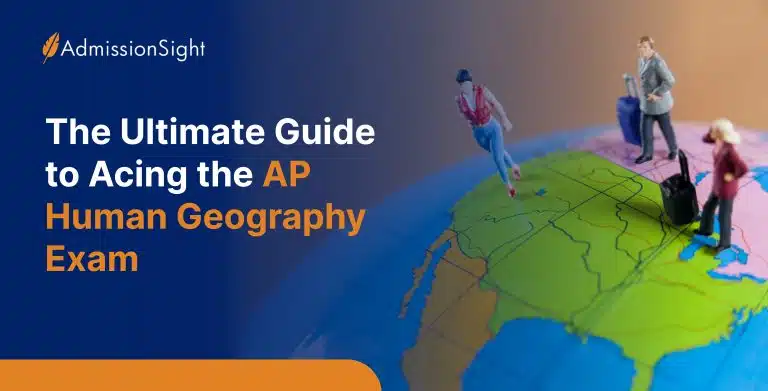Out of the 262,253 students who took the AP Human Geography Exam in 2024, 56.1% earned a score of 3 or higher, which most colleges consider a passing score. The average score, though, was 2.83. While more than half of the students do pass, it’s definitely not a breeze. You’ll need a good strategy to earn a top score.
This blog covers everything you need to know about the AP Human Geography Exam: what’s on it, how it’s structured, and how to study in a way that actually works.
- AP Human Geography Course and Exam Description
- AP Human Geography Exam Format
- AP Human Geography Exam Questions
- How to Study for the AP Human Geography Exam
- AP Human Geography Exam Test-Taking Tips
- AP Human Geography Exam Date
- Is the AP Human Geography Exam Hard?
- Frequently Asked Questions
- Takeaways
AP Human Geography Course and Exam Description
AP Human Geography focuses on how humans interact with their environment, how they shape and are shaped by the spaces they occupy, and how geographic processes influence culture, politics, economics, and urbanization.
The course introduces you to key concepts like spatial thinking, diffusion, globalization, and demographic patterns. You’ll analyze geographic models, interpret maps and data, and explain the relationships between people and place.
The class is designed to match the pace and expectations of a college-level introductory geography course. You don’t need any prerequisites, but having strong reading comprehension and the ability to think critically will help you a lot.
Since you’ll be working with a range of geographic tools and writing full explanations, being comfortable with structured arguments is important.
Map and data interpretation is a major part of the course. You’ll spend time analyzing spatial patterns using visual sources like population pyramids, choropleth maps, satellite imagery, and graphs. This will train your ability to explain patterns, identify trends, and understand geography from multiple perspectives.
AP Human Geography Exam topics
The AP Human Geography Exam covers seven main units, each of which carries a specific weight on the exam. Here’s a breakdown of the units and their approximate weightings:
|
Unit |
Weighting |
|
Thinking Geographically |
8–10% |
|
Population and Migration Patterns and Processes |
12–17% |
|
Cultural Patterns and Processes |
12–17% |
|
Political Patterns and Processes |
12–17% |
|
Agriculture and Rural Land-Use Patterns and Processes |
12–17% |
|
Cities and Urban Land-Use Patterns and Processes |
12–17% |
|
Industrial and Economic Development Patterns and Processes |
12–17% |
These percentages show how much of the exam is likely to focus on each unit.
For example, the Population and Migration unit makes up about 12 to 17% of the test, so you should expect to answer questions about population growth, migration causes, and demographic trends. The same goes for Cultural Patterns and Processes, where you’ll need to know how culture spreads, how it interacts with the landscape, and how elements like language and religion vary by region.
The weightings aren’t fixed. Some units may get more focus than others depending on the year. But overall, the higher the percentage, the more likely it is that you’ll see questions from that topic.
AP Human Geography Exam Format
The AP Human Geography Exam is split into two sections:
- Multiple-Choice Questions (MCQs)
- Free-Response Questions (FRQs)
Each section counts toward your final score, so you’ll need to prepare for both if you want a solid result.
Section I (50% of score)
First up is Section I, which makes up 50% of your total score.
Part A: Multiple-Choice Questions
- 60 questions
- 60 minutes
- About 30 to 40 percent are based on maps, graphs, tables, images, or other visual prompts
These questions often appear in sets and test your ability to interpret spatial data, apply geographic models, and analyze real-world patterns. You’ll also see some stand-alone questions that focus on pure concept recall and understanding.
Section II (50% of score)
Then comes Section II, which makes up the remaining 50% of your score. This is where the written answers come in.
Part A: Free-Response Questions
- 3 questions
- 1 hour and 15 minutes
- One question has no stimulus
- One question includes one stimulus (map, image, or dataset)
- One question includes two different stimuli
Each free-response question includes multiple parts labeled A, B, C, and so on. You’ll need to define terms, describe patterns, and explain causes and effects using geographic reasoning. Questions might involve interpreting maps, identifying relationships across scales, or evaluating the impact of a geographic process.
All parts of the AP Human Geography Exam are taken digitally through the Bluebook app. You’ll type your answers directly into the platform, and your responses will be scored by trained College Board readers.
How long is the AP Human Geography Exam?
The AP Human Geography Exam runs for 2 hours and 15 minutes, with time split between two main sections. The first part is all multiple-choice, and the second part focuses on free-response writing.
In Section I, you’ll have 60 minutes for 60 MCQs. For Section II, you’ll get 1 hour and 15 minutes to answer 3 FRQs.
You’ll need to pace yourself carefully. For the multiple-choice section, try to stay close to one minute per question. Don’t spend too long on any single item. If you’re stuck, move on and come back later if there’s time.
For the FRQs, aim to spend about 25 minutes on each question. That gives you time to read, plan, and write a clear response. If a question has seven subparts, try not to use up all your time on just A and B. Each part is usually worth the same number of points.
If you rush, you risk making avoidable mistakes. But if you go too slow, you’ll run out of time. Knowing how long the AP Human Geography Exam is gives you a chance to practice and build your timing strategy ahead of test day.
AP Human Geography Exam Questions
The AP Human Geography exam tests how well you understand geographic concepts and how they apply to real-world situations. You’ll answer multiple-choice and free-response questions that cover everything from population and migration to agriculture and urban development.
Here’s what to expect, along with real sample questions from the College Board.
Multiple-Choice Questions (MCQs)
The College Board doesn’t release official multiple-choice questions from recent AP Human Geography exams. That’s because they reuse and cycle through many of the questions in actual test administrations. To protect the integrity of the exam, they keep these items confidential.
But here’s an example of the kind of question you might see:
|
A country is experiencing a decline in its total fertility rate (TFR) over the last two decades. Which of the following is the most likely explanation? (A) Increased agricultural employment |
The correct Answer is (C). Urbanization and access to education, especially for women, are strongly linked to lower fertility rates. As women gain more autonomy and economic opportunities, they tend to delay childbirth and have fewer children overall. In contrast, high TFR is often tied to rural or agricultural societies with lower female education rates.
Free-Response Questions (FRQs)
The FRQs make up 50% of your exam score. You’ll answer 3 free-response questions in 1 hour and 15 minutes, and each one requires you to write complete responses, often with multiple parts. These questions ask you to explain geographic ideas and apply them to specific cases, models, or data.
Question 1: No stimulus
Here’s a real question from the 2024 AP Human Geography Free-Response Questions, Set 1, which focused on food availability, agricultural practices, and global trade:
|
The availability of food in the context of a growing world population is influenced by many social, environmental, and economic factors. A. Define the concept of carrying capacity. B. Describe ONE way that humans have altered the environmental sustainability of agricultural lands. C. Explain how transportation technology has increased economies of scale in the agricultural sector of less developed countries. D. Explain a likely negative economic outcome of Green Revolution agricultural practices on rural communities. E. Explain ONE weakness of Malthusian theory in predicting the relationship between food production and population growth in contemporary society. F. Explain how surplus food production has changed the global market for local agricultural products. G. Explain the degree to which Green Revolution agricultural practices were effective in reducing hunger in less developed countries. (Response must indicate the degree [low, moderate, high] and provide an explanation.) |
Here’s how to approach the question:
- Part A should define carrying capacity as the maximum number of people an area can support without harming the environment.
- Part B might describe how deforestation, overgrazing, or excessive fertilizer use can reduce long-term soil quality.
- In part C, strong answers will explain how better transportation systems allow goods to move faster and farther, making it cheaper to produce and distribute food on a large scale.
- For part D, a good explanation is that small farmers may be pushed out of business because they cannot afford expensive Green Revolution tools or chemicals.
- In part E, the weakness of Malthusian theory is that it didn’t anticipate how new technology would boost food production.
- For part F, a strong answer would explain how countries with food surpluses can dominate global markets and undercut local producers elsewhere.
- Finally, part G should state that the Green Revolution had a moderate effect, helping reduce hunger in many places but not reaching every region due to limited infrastructure or investment.
Question 2: One stimulus
Another question from the 2024 FRQ Set 1 involved a map showing ethnic neighborhoods across Los Angeles County, California. The map displayed high- and medium-density clusters of Asian ethnic groups.
Filipinos appeared in Carson, Cerritos, and Walnut. Korean populations were shown in Koreatown, Gardena, and Buena Park. Chinese communities appeared in Monterey Park, Alhambra, and Chinatown.
The map used dark gray to show high density and light gray to show medium density. County boundaries were marked, and neighborhood names were clearly labeled.
|
The map shows predominantly Asian ethnic neighborhoods in Los Angeles County, California. The names of the neighborhoods and the densities of the ethnic groups are identified on the map. A. Identify ONE neighborhood labeled on the map where two or more Asian ethnic groups reside. B. Describe the spatial pattern of Chinese ethnic neighborhoods labeled on the map. C. Explain ONE way immigrants may choose to assimilate into their new place of residence. D. Explain ONE way immigrants may preserve their ethnic traditions in their new place of residence. E. Describe ONE way that ethnic neighborhoods may contribute to a sense of place in large metropolitan areas such as Los Angeles. F. Explain how the process of redistricting may be used to decrease an ethnic community’s political power. G. Explain how the process of redistricting may be used to increase an ethnic community’s political power. |
Let’s break down the question:
- For part A, Carson is a good example because it shows both Filipino and Korean communities.
- In part B, Chinese neighborhoods are clustered in the northeastern areas like Alhambra and Monterey Park.
- Part C should explain that assimilation might involve learning English, joining local organizations, or adapting to local customs.
- For part D, preserving traditions could mean speaking native languages, celebrating cultural holidays, or running ethnic businesses.
- In part E, a strong response would say that ethnic neighborhoods help immigrants feel more at home and create cultural landmarks within a larger city.
- Part F should explain that splitting a community between districts can reduce their voting strength.
- Part G should say that keeping the community in one district can increase their political representation.
Question 3: Two stimuli
This final question came from the 2024 AP Human Geography FRQ Set 2. The question included a diagram of the Demographic Transition Model showing five stages of population change.
Alongside the diagram was a table with demographic data from 2019 for four countries: Japan, Germany, Portugal, and Croatia. The table included three variables for each country—birth rate per 1,000 people, death rate per 1,000 people, and the percent of the population over the age of 65.
For example, Japan had a birth rate of 7.0, a death rate of 10.7, and 28% of its population over 65. Germany’s numbers were 9.4, 11.3, and 22%, respectively.
|
The demographic transition model can be used to theorize the changes in a country’s total population over time. A. Select ONE country listed in the table and identify its stage in the demographic transition model. B. Define the concept of a pronatalist policy. C. Explain ONE factor that affects birth rates as countries move from stage 3 to stage 4 in the demographic transition model. D. Describe ONE likely economic effect when countries have negative population growth. E. Based on the data shown in the table, describe a policy that a government might develop in response to demographic change. F. Explain ONE reason why the life expectancy in urban areas may be higher than the life expectancy in the entire country. G. Using the data in the table, explain how, over time, low birth rates may impact the country’s percent of population over age 65. |
Let’s analyze this question step by step:
- For part A, Japan fits Stage 5 of the model. It has a very low birth rate, a slightly higher death rate, and a large elderly population.
- Part B should define a pronatalist policy as one that encourages people to have more children, often through financial or social incentives.
- In part C, birth rates fall because more women pursue education and careers, often delaying marriage and children.
- Part D should explain that negative population growth can lead to labor shortages and strain on pension systems.
- Part E might suggest tax breaks for families or programs to support working parents.
- For part F, a good answer would note that urban residents often live longer because they have better access to hospitals, clean water, and public services.
- Finally, part G should explain that low birth rates cause the population to age over time, leading to fewer workers and more retirees who rely on social support systems.
More than just naming terms, the best responses explain how those concepts apply to real-world scenarios and answer every part of the prompt clearly.
If you want to improve, review sample student responses from the College Board. Looking at how answers are scored can help you sharpen your explanations and make sure you’re addressing all the key ideas.
How to Study for the AP Human Geography Exam
The AP Human Geography Exam is all about patterns, processes, and how humans interact with the world. To do well, you need to understand concepts like migration, urbanization, and land use, and then apply them to real-world scenarios. You’ll need to actually understand what’s going on and why it matters.
Here’s how to study smart:
1. Study the AP Human Geography Course and Exam Description (CED).
The College Board’s official AP Human Geography Course and Exam Description lays out everything you need to know. It breaks the course into seven major units like Population and Migration, Agriculture, and Cities and Urban Land Use. Each unit includes key concepts and sample learning objectives.
Let’s say you’re reviewing Unit 3 on Cultural Patterns and Processes. You’ll want to focus on topics like language diffusion, religious conflicts, and the difference between folk and pop culture. The CED also includes sample questions and identifies which skills (like spatial thinking or data analysis) are tested most.
Use this as your main study roadmap. Match your review sessions to the concepts and skills listed in the CED, and you’ll be targeting exactly what the exam covers.
2. Use AP Human Geography practice exams.
Practice tests are your best friend. They show you how the College Board phrases questions and what kind of thinking you’ll be asked to do. The more you practice, the more confident and familiar you’ll be with the test style.
After each one, take the time to:
- Spot your weak areas. If you struggled with political boundaries or urban models, go back and review those topics.
- Review your mistakes. Did you misunderstand a question about centripetal forces? Did you confuse site and situation? Figure out what went wrong.
- Get your pacing right. You’ll have about a minute per multiple-choice question. For the free-response section, aim to write clear and complete responses in about 25 minutes each.
Use past exams or high-quality third-party practice materials. Just make sure they reflect the current format and content.
3. Know your vocabulary (and how to apply it).
Human Geo is vocab-heavy. You need to know terms like “relocation diffusion,” “gentrification,” “demographic transition,” and “ecumene.” But it’s not enough to define them—you have to apply them.
To practice:
- Make flashcards. Use physical cards or apps like Quizlet.
- Practice writing your own examples. For example, don’t just memorize “agglomeration.” Write a sentence about how tech companies cluster in Silicon Valley.
- Group similar terms. Group terms by theme, like “types of diffusion” or “development indicators.” This helps you remember how they’re connected.
4. Study maps, models, and spatial data.
The AP Human Geography Exam will expect you to interpret maps, charts, and models like the Von Thünen Model or the Demographic Transition Model. These visuals are not just there to illustrate ideas. They are essential content you need to understand and apply.
To improve:
- Practice with real maps. Use satellite images, population maps, and zoning maps. Try identifying patterns.
- Learn the classic models. Know what they show, when they apply, and their limitations. Can you sketch the Bid-Rent Curve from memory? What about Christaller’s Central Place Theory?
- Use map-based questions. Practice interpreting choropleth maps or analyzing density patterns based on different data visualizations.
5. Write free-response answers often.
FRQs make up half your score. The questions are straightforward, but they ask a lot. You’ll need to define, explain, and compare. You have to hit every part of the prompt, and there’s no fluff allowed.
Here’s how to prep:
- Write full answers under timed conditions. Don’t just outline. Actually write the full response, especially for multi-part questions.
- Label your responses. Use (a), (b), (c), etc. so it’s clear you’re answering every part.
- Be direct. No need for fancy transitions. Go straight to your point and use specific examples.
- Use geographic terms correctly. You’ll get points for accuracy, not for generalizations.
- Cite real places. If you’re talking about urban models, don’t just mention “a city”—name Atlanta or Lagos or Tokyo and explain why it fits.
Use scoring guidelines from past exams to check your work. This will help you see what real graders are looking for and how your responses measure up.
With the right strategy, you don’t have to memorize everything. You just need to understand how to apply what you know. Focus on practicing with real examples, reviewing key concepts, and building your writing confidence. That’s how you turn what you’ve studied into a strong AP Human Geography score.
AP Human Geography Exam Test-Taking Tips
A good study plan matters, but test-day strategy is just as important. Many students lose points not because they don’t know the material, but because they miss a key term, ignore a map, or forget to fully answer every part of the FRQ.
Here’s how to avoid those mistakes and maximize your score:
1. Manage your time wisely.
The AP Human Geography Exam takes 2 hours and 15 minutes. You’ll have 1 hour to answer 60 multiple-choice questions, and 1 hour and 15 minutes for 3 free-response questions. This gives you about a minute per MCQ and 25 minutes per FRQ.
Use your time carefully. For MCQs, don’t get stuck on difficult questions. If you’re unsure, make your best guess and move on. For FRQs, spend a couple of minutes planning, then focus on clearly answering each part of the prompt. Even a short but complete answer can earn points.
2. Read every part of the question.
Many FRQs have multiple parts labeled (a), (b), (c), and so on. Each part usually asks something slightly different: define, explain, apply, or compare. You won’t get credit for skipping sections, so answer every part fully and directly.
To avoid missing points:
- Look for directive words like “explain,” “identify,” or “describe.
- Watch for examples that must be specific, like naming a region or model.
- Check if the question focuses on change over time or regional differences.
3. Use visual materials carefully.
The AP Human Geography Exam often includes visuals like maps, graphs, models, or satellite images. They’re part of the prompt and must be analyzed just like text.
To handle visuals effectively:
- Always read the legend and labels. Check the scale, key, and any color shading or directional symbols. They tell you what the map or graph is really showing.
- Look for clear patterns. Ask yourself if the data is clustered, dispersed, or forming a specific trend across space.
- Match the visual to a concept. Think about what you’re seeing and connect it to a geography topic like urban models, migration patterns, or population growth.
- Use what you see in your answer. Don’t just mention the image. Explain how it supports your claim or helps answer the question.
Great answers don’t just describe the visual. They use it to back up real geographic ideas and show understanding.
4. Eliminate wrong answers on MCQs.
You don’t need to know the answer immediately. Start by removing obviously wrong options, then compare what’s left.
Other tips for MCQs:
- Be cautious with extreme language like “always” or “never.”
- Think spatially. If a question asks about economic activity or political organization, visualize what that looks like on the ground.
- If a source is provided, such as a population pyramid or migration map, analyze it first. Don’t skip straight to the answer choices.
5. Be clear and specific in your writing.
FRQs are scored based on what you write, not what you imply. Keep your responses focused and use concrete examples.
To improve your FRQ writing:
- Define terms in your own words. Don’t just copy definitions from a textbook or memorize phrases. Show that you understand the meaning by explaining the concept in a way that fits the question.
- Use human geography models (like the Demographic Transition Model or Von Thünen Model) correctly and apply them to real-world contexts. It’s not enough to mention the model. You need to explain how it works and give specific examples that show its relevance. Connect the model to patterns or trends you’ve studied.
- Give named examples when asked. Generic phrases like “a country in Asia” are too vague and won’t earn full credit. Use specific, accurate examples like “Japan,” “India,” or “Brazil” to demonstrate your geographic knowledge and support your explanation.
Practicing these habits will help you stay calm, focused, and efficient on test day. The more familiar you are with the question types and visuals, the more confident you’ll feel when it counts.
AP Human Geography Exam Date
The AP Human Geography Exam is scheduled for Tuesday, May 6, 2025, at 8 AM local time. This is a morning paper-and-pencil exam, so get ready for an early start. Your school will give you the details for where to report and what to bring, but expect to be there at least 30 minutes before the exam begins.
If you’re taking other AP exams too, make sure you know each date and time. To find test dates for other AP exams and registration details, check out our comprehensive guide.
AP Human Geography Exam score release date
AP scores for 2025 will start rolling out on Monday, July 7, 2025. That’s when students will be able to log in to the College Board website and view their individual scores, including the AP Human Geography Exam.
Make sure your College Board login details are up-to-date and easy to access. If you’re taking more than one AP exam, your scores will likely all be released at the same time.
Additional files like Scholar Awards and student data reports will follow on July 14, but those are mostly for school staff.
Is the AP Human Geography Exam Hard?
AP Human Geography has a reputation for being one of the more approachable AP exams, especially for first-time test-takers, but the numbers tell a more complex story. If you’re wondering how students performed in 2024, here’s the score breakdown:
|
Score |
Percentage of Students |
|
5 |
17.9% |
|
4 |
20.5% |
|
3 |
17.8% |
|
2 |
14.3% |
|
1 |
29.5% |
|
Total Passing (3+) |
56.1% |
Out of 262,253 students, just over half scored a 3 or higher, with a mean score of 2.83. That puts it on the lower end compared to other AP exams. Nearly 30% of test-takers received the lowest possible score, which shows that even “easier” APs require serious prep.
To do well, you need to understand how to apply concepts like the Demographic Transition Model, urban and agricultural patterns, and theories of development to real-world case studies. Memorizing terms is not enough. You have to show how those ideas work in context.
If you’re aiming for a 4 or 5, focus on practicing FRQs, reviewing case studies, and using geographic models with clear explanations. Scoring high takes more than recognition. It takes interpretation and precision.
If you want extra help, check out our AP tutorial services. We’ll walk you through map skills, model analysis, and FRQ writing techniques so you can go into test day fully prepared.
Frequently Asked Questions
1. How hard is the AP Human Geography Exam?
The AP Human Geography Exam is moderately difficult. In 2024, 56.1% of students scored a 3 or higher, but only 17.9% earned a 5. That means passing is achievable for most students, but getting a top score takes more than just memorization. The test covers a wide range of human topics like population, migration, agriculture, urbanization, and industrial development.
It places a strong emphasis on spatial thinking, real-world applications, and interpreting visual data such as maps and models. It’s less writing-heavy than AP World History but still more conceptual than AP Environmental Science, which some students consider a content-heavy course.
2. How many hours should you study for the AP Human Geography Exam?
That depends on your background, but most successful students spend around 70 to 90 hours preparing. If you’re aiming for a 4 or 5, try to study 3 to 4 hours a week for a few months. Use that time not only to review terms but also to practice FRQs, work on map skills, and test yourself on real-world applications of key models.
3. Do you need to memorize everything for the AP Human Geography Exam?
No. You’ll need to remember important concepts and vocabulary, but the exam goes beyond recall. It asks you to apply geographic models and theories, analyze patterns, and explain how different processes play out across places and scales.
Focus your review on the Course and Exam Description (CED), which outlines the key themes and essential knowledge. This helps you prioritize what matters and avoid cramming unnecessary details.
4. Is AP Human Geography worth taking?
If you’re curious about how people interact with places and how geography shapes culture, development, and globalization, AP Human Geography is a great pick. It’s often one of the first AP courses students take, and it builds a strong foundation for AP Environmental Science, World History, and other social science subjects.
Many schools recognize it for college credit, and it shows you’re ready for college-level coursework that involves data analysis, critical thinking, and essay writing.
5. When do AP Human Geography scores come out?
You’ll be able to view your score on Monday, July 7, 2025, by logging into your College Board account. If you’re sending your score to a college, be sure to submit your request before the June deadline so it arrives in time for fall admissions or credit evaluations.
Takeaways
Here are the key takeaways to keep in mind as you study for the AP Human Geography Exam:
- The AP Human Geography Exam covers seven major units including topics like migration, urban development, and agriculture. You’ll need to understand not just the definitions, but the geographic processes behind them.
- Both sections of the AP Human Geography Exam carry equal weight, so you can’t just rely on multiple-choice skills. Strong FRQ writing is key to getting a high score.
- Interpreting maps and models is essential on the AP Human Geography Exam. You’ll be expected to apply tools like the Demographic Transition Model, the Von Thünen Model, and choropleth maps to real-world scenarios.
- A passing score is common, but top scores are harder to earn. In 2024, over 262,000 students took the AP Human Geography Exam, and only 17.9% earned a 5. Strategic preparation makes the difference.
- Need help preparing for the AP Human Geography Exam? A college admissions consultant can help you master tough topics, sharpen your FRQ responses, and gain the confidence you need to earn a top score.

Eric Eng
About the author
Eric Eng, the Founder and CEO of AdmissionSight, graduated with a BA from Princeton University and has one of the highest track records in the industry of placing students into Ivy League schools and top 10 universities. He has been featured on the US News & World Report for his insights on college admissions.






















